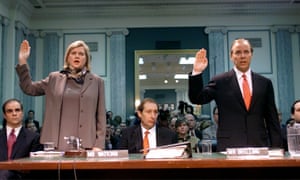
Illustration by Dom McKenzie
Tomorrow, President Trump arrives in London for the annual Nato summit. Despite the boasting and the trappings of superpower status, he is an emissary from a country whose economy and society are in increasing difficulty, and whose global leadership is under challenge not just from the usual suspect, China, but from Europe. With the unerring capacity to be wrong that defines the Brexit right, Britain is about to decouple itself from a continental economy beginning to get things right, and hook up with one that is palpably beginning to fail.
This is not the conventional wisdom. The EU is sclerotic, undynamic, stifled by quasi-socialist red tape, and hostile to insurgent startups. It is so degenerate it cannot even defend itself – as Trump will undoubtedly remind its leaders over the next two days. The US is the mirror opposite. A free trade agreement post 31 January with the US is the number one strategic policy aim for Brexit Britain – unshackling the UK from the declining old, and embracing the English-speaking, dynamic new. Best be nice to “the Donald”.
Except the latest research demonstrates the reverse is true. Britain is about to make a vast mistake. In the recently published The Great Reversal, leading economist Thomas Philippon of New York University and member of the advisory panel of the New York Federal Reserve, mounts a devastating attack on the conventional wisdom, so perfectly embodied by the witless Boris Johnson. The news is that over the last 20 years per capita EU incomes have grown by 25% while the US’s have grown 21%, with the US growth rate decelerating while Europe’s has held steady – indeed accelerating in parts of Europe. What is going on?
Philippon’s answer is simple. The US economy is becoming increasingly harmed by ever less competition, with fewer and fewer companies dominating sector after sector – from airlines to mobile phones. Market power is the most important concept in economics, he says. When firms dominate a sector, they invest and innovate less, they peg or raise prices, and they make super-normal profits by just existing (what economists call “economic rent”). So it is that mobile phone bills in the US are on average $100 a month, twice that of France and Germany, with the same story in broadband. Profits per passenger airline mile in the US are twice those in Europe. US healthcare is impossibly expensive, with drug companies fixing prices twice as high or even higher than those in Europe; health spending is 18% of GDP. Google, Amazon and Facebook have been allowed to become supermonopolies, buying up smaller challengers with no obstruction.
This monopolising process gums up everything. Investment in the US has been falling for 20 years. Because prices stay high, wages buy less, so workers’ lifestyles, unless they borrow, get squeezed in real terms while those at the top get paid ever more with impunity. Inequality escalates to unsupportable levels. Even life expectancy is now falling across the US.
But why has this happened now? Philippon has a deadly answer. A US political campaign costs 50 times more than one in Europe in terms of money spent for every vote cast. But this doesn’t just distort the political process. It is the chief cause of the US economic crisis.
Corporations want a return on their money, and the payback is protection from any kind of regulation, investigation or anti-monopoly policy that might strike at their ever-growing market power. Boeing, for example, ensured – as one of the US’s biggest lobbyists – that regulation was friendly to its plans to shoehorn heavier engines on to a plane not designed for them – the fatal shortcut behind the two crashes of the 737 Max 8. Philippon shows this is systemic; how both at federal and state level ever higher campaign donations are correlated with ever fewer actions against monopoly, price fixing and bad corporate behaviour.
In Europe, the reverse is true. It is much harder for companies to buy friendly regulators. The EU’s competition authorities are much more genuinely politically independent than those in the US – witness the extraordinary fines levied on Google or the refusal this February to allow Siemens to merge with the French giant Alstom. As a result, it is Europe, albeit with one or two laggards such as Italy, that is bit by bit developing more competitive markets, more innovation and more challenge to incumbents while at the same time sustaining education and social spending so important to ordinary people’s lives.
Even starting up businesses is now easier. France is generating multiple hi-tech startups, with unemployment falling. Parts of Paris, Barcelona, Amsterdam or even Milan are now rivalling San Francisco’s Bay area.
The EU’s regulations are better thought out, so in industry after industry it is becoming the global standard setter. Its corporate governance structures are better. And last week, to complete the picture, Christine Lagarde, the incoming president of the European Central Bank, in the most important pronouncement of the year, said the environment would be at the heart of European monetary policy. In other words, the ECB is to underwrite a multitrillion-euro green revolution. In short – bet on Europe not the US.
Thus Jeremy Corbyn, seizing on leaked documents showing how US trade negotiators want UK drug prices to rise to US levels, is on to something much bigger than the threat to the NHS, fatal though that is. Any trade deal with the US will require the UK to accept the protections that are making US capitalism so sclerotic, predatory and high priced – while dissociating itself from a European capitalism that is not only beginning to outperform America’s, but so much better reflects our values.
This election is set to seal not just the geopolitical but geo-economic mistake of Britain’s recent history. The tragedy is that our national conversation is hardly aware of how high the stakes have become.
Tomorrow, President Trump arrives in London for the annual Nato summit. Despite the boasting and the trappings of superpower status, he is an emissary from a country whose economy and society are in increasing difficulty, and whose global leadership is under challenge not just from the usual suspect, China, but from Europe. With the unerring capacity to be wrong that defines the Brexit right, Britain is about to decouple itself from a continental economy beginning to get things right, and hook up with one that is palpably beginning to fail.
This is not the conventional wisdom. The EU is sclerotic, undynamic, stifled by quasi-socialist red tape, and hostile to insurgent startups. It is so degenerate it cannot even defend itself – as Trump will undoubtedly remind its leaders over the next two days. The US is the mirror opposite. A free trade agreement post 31 January with the US is the number one strategic policy aim for Brexit Britain – unshackling the UK from the declining old, and embracing the English-speaking, dynamic new. Best be nice to “the Donald”.
Except the latest research demonstrates the reverse is true. Britain is about to make a vast mistake. In the recently published The Great Reversal, leading economist Thomas Philippon of New York University and member of the advisory panel of the New York Federal Reserve, mounts a devastating attack on the conventional wisdom, so perfectly embodied by the witless Boris Johnson. The news is that over the last 20 years per capita EU incomes have grown by 25% while the US’s have grown 21%, with the US growth rate decelerating while Europe’s has held steady – indeed accelerating in parts of Europe. What is going on?
Philippon’s answer is simple. The US economy is becoming increasingly harmed by ever less competition, with fewer and fewer companies dominating sector after sector – from airlines to mobile phones. Market power is the most important concept in economics, he says. When firms dominate a sector, they invest and innovate less, they peg or raise prices, and they make super-normal profits by just existing (what economists call “economic rent”). So it is that mobile phone bills in the US are on average $100 a month, twice that of France and Germany, with the same story in broadband. Profits per passenger airline mile in the US are twice those in Europe. US healthcare is impossibly expensive, with drug companies fixing prices twice as high or even higher than those in Europe; health spending is 18% of GDP. Google, Amazon and Facebook have been allowed to become supermonopolies, buying up smaller challengers with no obstruction.
This monopolising process gums up everything. Investment in the US has been falling for 20 years. Because prices stay high, wages buy less, so workers’ lifestyles, unless they borrow, get squeezed in real terms while those at the top get paid ever more with impunity. Inequality escalates to unsupportable levels. Even life expectancy is now falling across the US.
But why has this happened now? Philippon has a deadly answer. A US political campaign costs 50 times more than one in Europe in terms of money spent for every vote cast. But this doesn’t just distort the political process. It is the chief cause of the US economic crisis.
Corporations want a return on their money, and the payback is protection from any kind of regulation, investigation or anti-monopoly policy that might strike at their ever-growing market power. Boeing, for example, ensured – as one of the US’s biggest lobbyists – that regulation was friendly to its plans to shoehorn heavier engines on to a plane not designed for them – the fatal shortcut behind the two crashes of the 737 Max 8. Philippon shows this is systemic; how both at federal and state level ever higher campaign donations are correlated with ever fewer actions against monopoly, price fixing and bad corporate behaviour.
In Europe, the reverse is true. It is much harder for companies to buy friendly regulators. The EU’s competition authorities are much more genuinely politically independent than those in the US – witness the extraordinary fines levied on Google or the refusal this February to allow Siemens to merge with the French giant Alstom. As a result, it is Europe, albeit with one or two laggards such as Italy, that is bit by bit developing more competitive markets, more innovation and more challenge to incumbents while at the same time sustaining education and social spending so important to ordinary people’s lives.
Even starting up businesses is now easier. France is generating multiple hi-tech startups, with unemployment falling. Parts of Paris, Barcelona, Amsterdam or even Milan are now rivalling San Francisco’s Bay area.
The EU’s regulations are better thought out, so in industry after industry it is becoming the global standard setter. Its corporate governance structures are better. And last week, to complete the picture, Christine Lagarde, the incoming president of the European Central Bank, in the most important pronouncement of the year, said the environment would be at the heart of European monetary policy. In other words, the ECB is to underwrite a multitrillion-euro green revolution. In short – bet on Europe not the US.
Thus Jeremy Corbyn, seizing on leaked documents showing how US trade negotiators want UK drug prices to rise to US levels, is on to something much bigger than the threat to the NHS, fatal though that is. Any trade deal with the US will require the UK to accept the protections that are making US capitalism so sclerotic, predatory and high priced – while dissociating itself from a European capitalism that is not only beginning to outperform America’s, but so much better reflects our values.
This election is set to seal not just the geopolitical but geo-economic mistake of Britain’s recent history. The tragedy is that our national conversation is hardly aware of how high the stakes have become.



